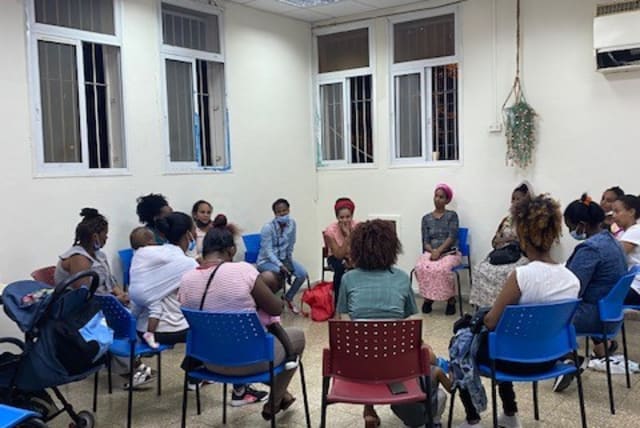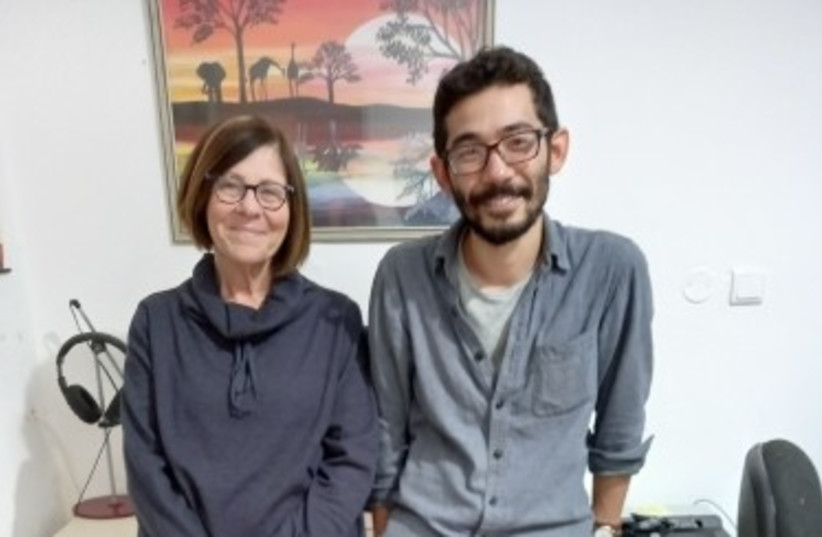African asylum-seekers in Haifa struggle for survival

While most of the 28,000 asylum-seekers in Israel live in Tel Aviv, those in Haifa, numbering up to 800, are far less visible.
While African asylum-seekers in Tel Aviv are always featured in the media, this writer was surprised to hear that there is a smaller but substantial community of Eritrean and Sudanese refugees in my own city, Haifa.
Speaking with Naomi Feigin, a full-time volunteer, and Kei Ishii, founder and program director of Irgun L’Ma’an Plitim-ALEF (Organization for Refugees in Haifa) in their small office on the Hadar, they described the needs of these asylum-seekers and how their organization tries to fill in some of the gaps.
Ishii, of Japanese-American origin, made aliyah in 2014 and completed his Masters in Global Migration and Policy at Tel Aviv University. He started to teach but realized that there are far deeper issues in our society. This inspired him to establish this grassroots organization affiliated with the African Refugees Development Center,(ARDC), a Tel Aviv NGO that was founded in 2004.
“They are our mentor,” he explains.
Feigin, an Australian-born social worker, has a long track record in volunteerism. She served as president of the Moriah Masorati Synagogue for many years, and in the 1980s was part of the cooperative that ran the Shelter for Battered Women, the first women’s shelter in Israel founded in 1977 by Marsha Friedman and four other women, at a time when there was little awareness of domestic violence.
“Israel has an obligation to process asylum seekers and refugee claims,” says Ishii, “but by not giving an answer for the vast majority of cases, the Interior Ministry leaves this population in status limbo.”
The government calls the asylum-seekers “infiltrators,” and that is documented on their temporary visas.
“Our job as volunteers is to support them through all the bureaucracy, filling in all the forms to get their minimal benefits, negotiating with public institutions,” says Feigin. “There are services available but they aren’t always accessible to them. The main obstacle is that they do not have an Israeli ID card. Without that they can’t get a credit card, subscribe to a telephone company, register at a Kupat Holim, make appointments at Bituah Leumi (National Insurance Institute) or get a Rav Kav (public transportation card). Imagine how difficult life is without those documents.”
She said that the resources for getting phones or transportation cards and other services become much more expensive.
The Meuhedet health fund provides services for the children, but the adults have to seek private medical care. There are two free clinics for people without status in Haifa, with volunteer doctors who provide health care services and health education to the community.
While most of the 28,000 asylum-seekers in Israel live in Tel Aviv, according to ASSAF (Aid Organization for Refugees and Asylum Seekers in Israel), those in Haifa, numbering up to 800, are far less visible.
“When we started, we tried to keep a low profile,” says Feigin, fearing backlash from Israeli groups that might take issue with the organization. “It also took time to gain the trust of the refugees who now see us as partners.”
Adds Ishii, “Government officials and social workers often want to help, but their hands are tied by all the restrictions and bureaucracy. The Israeli High Court didn’t grant unrestricted permission to work, but agreed that they have to be able to support their families. In lieu of Bituah Leumi [national insurance] and other rights that protect workers, asylum seekers have deductions from their salaries, in addition to a foreign workers tax for the employer. This left asylum seekers going home with partial paychecks and unable to make a living wage.”
“They work incredibly hard,” says Feigin, “long shifts in menial jobs.” But she did add that the more skilled refugees, specifically those with command of the Hebrew language, can get better jobs and improve their quality of life. She spoke of their remarkable resilience after the traumas they suffered in Eritrea and Sudan and on their journey of escape, as well as the difficulties they face trying to sustain and protect their families while seeking asylum in Israel.
“We should not underestimate the strengths and resources of the refugees themselves,” Feigin says. “They help each other and are a very supportive community.”
The Eritreans are Christians so they have established small churches in the neighborhood. Abugida, a community-based after-school program, maintains the children’s knowledge of the Triginian language and teaches them their heritage.
Language is the key to the quality of life and job opportunities for these refugees, as it is for all new Jewish immigrants. The difference is that they do not receive the support and benefits given to legal immigrants including access to an ulpan (Hebrew class), nor do they have any cultural background in the language.
Lynne Toubkin, a British-born Haifa resident, volunteers her skills as an experienced educator to organize classes in English and in Hebrew for both adults and children.
“We have been giving language instruction to both the adults and children either in groups or as one-to-one teaching,” Toubkin says. “The curriculum is built around their needs and requests for specific topics. Some of the families already speak English because of their background or the places they have stayed in during their time in Israel.”
In addition, during the past two years, ALEF has been giving support to the children with their school homework. Until last year, all the teaching programs were run by volunteers with teaching experience, or after being given some training sessions. Last year an extra new program was set up in Haifa via the ARDC in Tel Aviv called The School House Project. Funded by donations, this provides a specific program of teaching English suitable for the refugee population. These teachers receive minimum payment.
“My role was originally as a volunteer teacher for the children,” says Toubkin. “I now oversee all the separate and varied programs.”
While we talked, tutors from the Mechinat Rabin, a six-month pre-army community service, were preparing another room in the flat to teach a group of children. Ishii attended to a refugee who had come to collect packets of lentils and corn kernels, basic food that was donated to ALEF. The poorer asylum seekers receive food once a month from Lev Chash, an NGO that works in cooperation with the municipality. This organization has been working in Haifa for 20 years, and has multiple volunteer projects to assist the poor and needy, mentoring sick children and their families and housing Holocaust survivors.
After our meeting, Feigin was on her way to look after babies and young children while their mothers attended a Women`s Empowerment Group, funded by the Magal Nashim (Women’s Circle) of the Reform Movement.
Apart from language classes for the children, seven Eritrean children enjoy art therapy with Master’s students from Tel Chai Academic College every week.
The Municipality has provided the Moadonit for the art therapy and the women’s group. Keren Haderim has given ALEF premises that provide a space for the office and is also used as a teaching center.
During the periods of lockdown, the isolation of the refugees exacerbated their dire situation. Donated provisions were delivered to their homes and contact was maintained. It was a period of hardship as all social activities were suspended.
Students from the Technion Faculty of Medicine, as part of their “community engagement course,” under the supervision of Professor Ruth Margalit, taught the children online education programs on tablets donated by the Schusterman Foundation.
As a social worker herself, Feigin empathizes with the struggle for survival, and attempts to find the appropriate resources for the asylum seekers. “The Municipality social workers are involved in the more serious cases, domestic violence, child neglect.”
The refugees live in appalling conditions around the shuk in the Hadar neighborhood, which was originally designed as a garden city. After decades of neglect, today there are boarded-up shops and many buildings in disrepair.
However an urban renewal is underway with Keren Hadarim, which is buying real estate around the shuk to provide affordable long-term rentals using sustainable and environmentally beneficial materials. This fund is an Israeli partnership that invests in urban renewal combining physical and social aspects in Haifa’s Old City. The model is a multi-sector collaboration with the Haifa municipality, local communities and qualified architects and town planners.
Respecting the multi-cultural population in this neighborhood, they provide social benefits together with community involvement, creating a community garden and encouraging artists and artisans to set up their studios in the neighborhood.
“Our vision is to work in consultation with the refugees, fill in some of the gaps, educate the adults and children, provide enrichment activities and help them negotiate their way through the bureaucracy,” Ishii concluded. “Nobody gets asylum, but we aim to better their lives and maintain their dignity.” ■
Jerusalem Post Store
`; document.getElementById("linkPremium").innerHTML = cont; var divWithLink = document.getElementById("premium-link"); if (divWithLink !== null && divWithLink !== 'undefined') { divWithLink.style.border = "solid 1px #cb0f3e"; divWithLink.style.textAlign = "center"; divWithLink.style.marginBottom = "15px"; divWithLink.style.marginTop = "15px"; divWithLink.style.width = "100%"; divWithLink.style.backgroundColor = "#122952"; divWithLink.style.color = "#ffffff"; divWithLink.style.lineHeight = "1.5"; } } (function (v, i) { });

